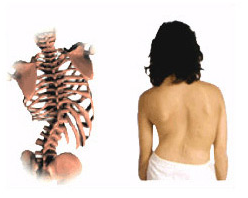SCOLIOSIS – A condition of curvature of the spine.
A normal spine should be straight when viewed from the back. In scoliosis there is an abnormal side to side curve. This may result in deformity of the back and may lead to an uneven waist, uneven shoulders, prominent shoulder blades or elevated hips. The patient may even lean to one side. In most individuals scoliosis does not cause pain.
A lateral (away from the middle) or sideways curvature of the spine (scoliosis) generally begins just at the onset of puberty and progresses during the adolescent growth spurt. If caught early, progressive spine curvature can be prevented. Scoliosis affects girls much more frequently than boys.
Causes
There are three general causes of scoliosis:
- Idiopathic (of unknown cause) – appears in a previously straight spine for no reason.
- Congenital – usually related to a problem with the formation of vertebrae or fused ribs during prenatal development.
- Neuromuscular – poor muscle control or muscular weakness or paralysis due to diseases like cerebral palsy, muscular dystrophy, spina bifida and polio.
The idiopathic form in adolescents is the most common and may have a genetic predisposition. Most cases occur in girls and curves generally worsen during growth spurts. There are also infantile and juvenile forms that are less common and affect a similar number of boys and girls.
The greater the initial curve of the spine, and the younger the patient at diagnosis, the greater the chance of progression of the curve. Severe scoliosis (curves in the spine greater than 100°) may cause breathing (respiratory) problems.
 Signs
Signs
- The spine curving abnormally to the side (laterally)
- Shoulders and/or hips appearing uneven
- Loin crease
- Rotation of the pelvis
Signs and Tests
The physical examination will include a forward bending test that will help the practitioner define the curve. There will also be a thorough neurologic exam to look for any changes in strength, sensation or reflexes.
Tests may include:
- Spinal x-rays (taken from the front and the side)
- Scoliometer measurements ( a device for measuring the curvature of the spine)
- MRI (if there are any neurologic changes noted on the exam or if there is something unusual in the x-ray)
